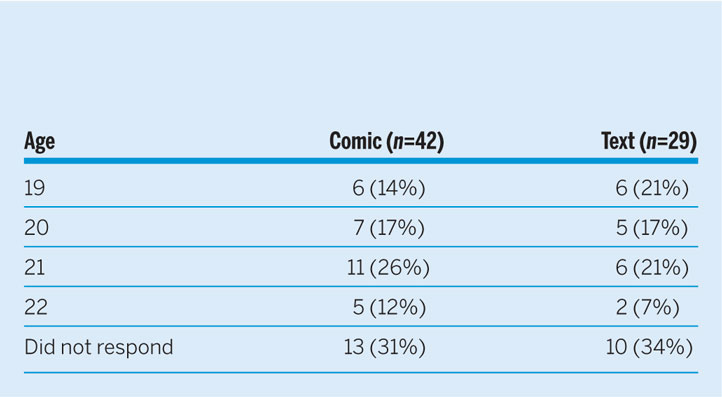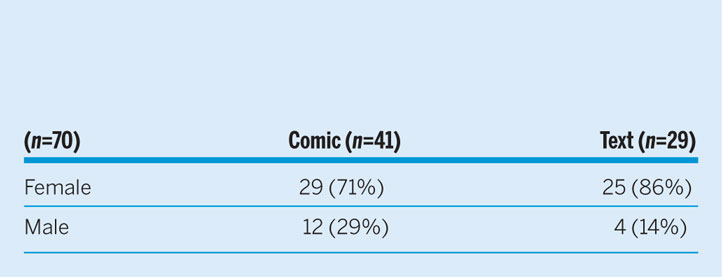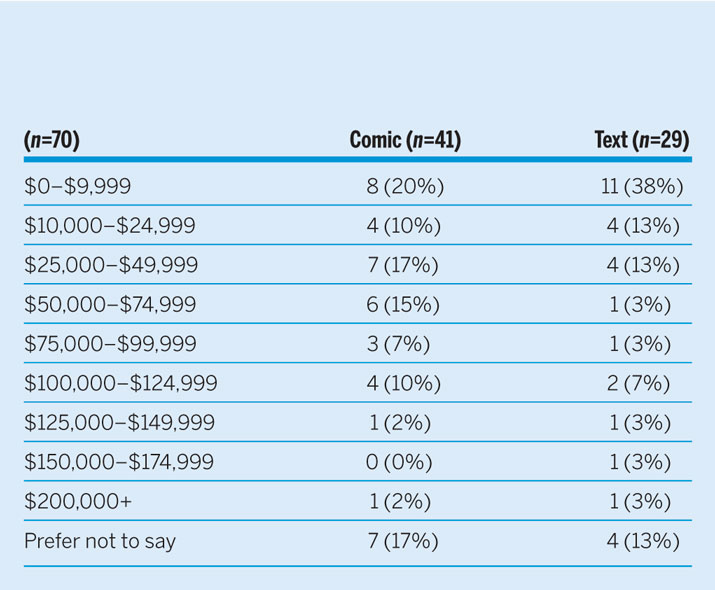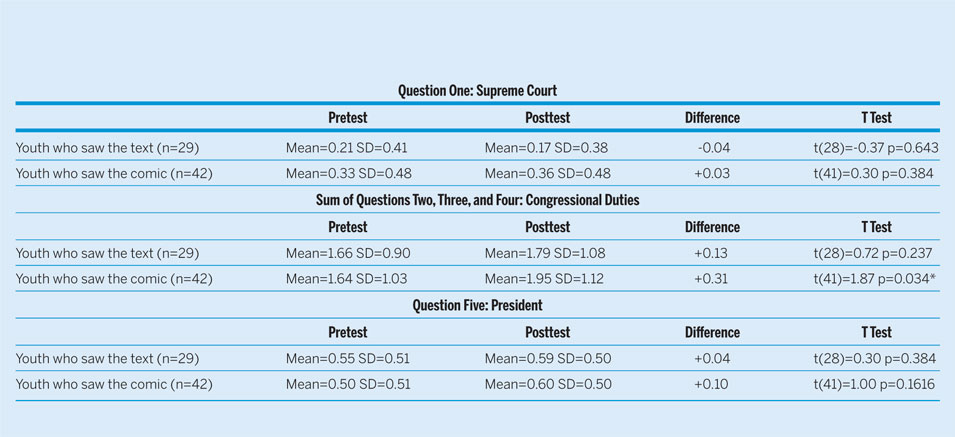Foundational documents such as the Declaration of Independence and the US Constitution can provide important insight into the structure and function of American government. Yet, these texts can be difficult for college students to read and comprehend. The style in which the Constitution is written at times obfuscates its meaning for students. Whereas faculty may see the value of introducing primary documents, frustrated students may quickly give up on difficult material. The goals of this article are twofold: (1) to understand whether a visual depiction of the Constitution might help a reader digest this difficult text, and (2) to briefly share one way that we use this method in the classroom. This article highlights how arts-based learning—particularly visual images elucidating content—may be a powerful tool to help students understand difficult political documents.
BACKGROUND
By exploring the literature on knowledge and engagement, arts-based learning, and comics in the classroom, we can better understand how previous work on these topics fuels this research.
Linking Knowledge and Engagement
Understanding the way government works is critical to becoming an active participant. A 1999 study of civic knowledge and behavior of 14-year-olds in 28 countries found that the respondents had fundamental, albeit shallow, knowledge about politics and government (Torney-Purta et al. Reference Torney-Purta, Lehmann, Oswald and Schulz2001). The authors wrote that, excluding voting, many students do not find political engagement important, noting that they would be “unlikely to join a political party, [to] consider writing a letter to a newspaper about a social concern, or [to] become a political candidate in the future” (Torney-Purta et al. Reference Torney-Purta, Lehmann, Oswald and Schulz2001, 180). A 2009 update of this study included 38 countries and demonstrated a decline in civic knowledge in nearly half of the 15 countries that were a part of both studies (Schulz et al. Reference Schulz, Ainley, Fraillon, Kerr and Losito2010). In addition, voting participation is low among youth: the Center for Information and Research on Civic Learning and Engagement (2016) reported that approximately 50% of eligible 18- to 29-year-old US citizens voted in the 2016 presidential election. In research on youth in the United Kingdom, Sloam (Reference Sloam2008) emphasized the important role that political science education plays in rejuvenating political engagement. Although not the goal of this study, political participation is a public good that is critical to creating inclusive and representative democratic government.
Arts-Based Learning
Arts-based education is one promising method of involving a range of learners on social topics (Clover Reference Clover2000; Curtis Reference Curtis2011; Curtis, Reid, and Reeve Reference Curtis, Reid and Reeve2014; Dewhurst Reference Dewhurst2011; Graham Reference Graham2007; Lawrence Reference Lawrence2005). Education that utilizes the arts respects multiple ways of knowing and has the potential to more fully and more creatively explore topics, thereby allowing for the development of deeper knowledge (Curtis, Reid, and Reeve Reference Curtis, Reid and Reeve2014; Dewhurst Reference Dewhurst2011; Graham Reference Graham2007; Lawrence Reference Lawrence2005). Arts-based learning or visual learning may be used in combination with other modes in the classroom. Universal Design for Learning (UDL) is “a framework to improve and optimize teaching and learning for all people based on scientific insights into how humans learn” (CAST 2019). Proponents of UDL posit that accessing material in multiple ways (e.g., visual, audial, and tactile) supports more student learning styles (Schreiner, Rothenberger, and Sholtz Reference Schreiner, Rothenberger and Sholtz2013). Frey and Fisher (Reference Frey and Fisher2008, 1) noted that “visually literate learners…make connections, determine importance, synthesize information, evaluate, and critique” and, when combined with text, this yields a “more complete understanding” of material. Visual or arts-based learning is one tool that faculty can use to captivate students and improve learning.
According to a 2010 study based in Turkey, effective cartooning in the classroom improves instruction, supports active learning, enables critical thinking, and may play a role in higher academic achievement (Birisci, Metin, and Karakas Reference Birisci, Metin and Karakas2010).
Comics in the Classroom
The use of comics in the classroom is not new. Many educators use humorous cartoons to lighten lectures or teach topics in a fun and engaging way (Park, Kim, and Chung Reference Park, Kim and Chung2011). Much of the research on learning via images stems from the field of concept cartoons. Concept cartoons are not humorous panels about a topic—political or otherwise—but rather most often a visual depiction of a scientific concept that features one correct conceptualization and common alternate but incorrect conceptualizations (Akamca, Ellez, and Hamurcu Reference Akamca, Ellez and Hamurcu2009; Keogh and Naylor Reference Keogh and Naylor1999). Expressed another way, concept cartoons depict a group of students puzzling out explanations for observed phenomena. Only one correct answer exists for each concept cartoon. In this way, concept cartoons help students explore and think through correct and incorrect answers to a question, ruminating on why they may be right or wrong. An example from the field of chemistry shows a group of students asking why nails rust (Millgate House Education 2014). They give alternate explanations—one student posits that a nail will not rust in the cold; another claims that a wet nail will rust; a third surmises that contact with other rusty nails will cause a nail to rust; and a fourth student infers that a nail will not rust when under water (Millgate House Education 2014). Rusting happens when both air and water are present; therefore, the correct answer is that a wet nail will rust (Millgate House Education 2014). Students explored the options presented in the concept cartoon to understand the concept. In a study combining quantitative and qualitative methods to assess science learning of fourth-graders, Akamca, Ellez, and Hamurcu (Reference Akamca, Ellez and Hamurcu2009) found that concept cartoons positively affect student achievement. Keogh and Naylor (Reference Keogh and Naylor1999) reported that concept cartoons support learning through enabling discussion and supporting inquiry. Kabapinar (Reference Kabapinar2005) wrote that, among other results, teaching through the use of concept cartoons resolves student misconceptions on content; however, she emphasized the importance of student–teacher interaction and discussion of the concept cartoon.
Researchers in a range of disciplines use visual imagery—if not specifically concept cartoons—to engage students. Tatalovic (Reference Tatalovic2009) reviewed the use of comics in the sciences and found that they have been successfully employed since the nineteenth century to explain scientific principles to both students and the public. Park, Kim, and Chung (Reference Park, Kim and Chung2011) combined humor and content, creating comics to enhance anatomy lectures at the Ajou University School of Medicine in Korea. According to a 2010 study based in Turkey, effective cartooning in the classroom improves instruction, supports active learning, enables critical thinking, and may play a role in higher academic achievement (Birisci, Metin, and Karakas Reference Birisci, Metin and Karakas2010). Williams (Reference Williams2008, 13) found that comics in particular can assist in “crossing boundaries, creating empathy, and educating students about the artistic production and consumption of powerful texts.” Investigating the use of comic books to teach science to non-majors, Hosler and Boomer (Reference Hosler and Boomer2011) reported statistically significant gains among this group’s content knowledge, attitudes about biology, and attitudes about comics. Using comics and cartoons to teach algebraic concepts, Toh (Reference Toh2009) noted that they allow teachers to engage students, yielding increases in motivation. In working with college-level engineering students, Wylie and Neely (Reference Wylie and Neeley2016) observed that the use of comics allows students to retain knowledge of complex concepts. Political science faculty at many levels use comics and visual images to teach. It is not uncommon to employ political or editorial cartoons in the politics classroom as tools to elucidate ideas, share political opinion, review political history, and teach critical and analytical thinking (Dougherty Reference Dougherty2002; Owens Reference Owens and Byrne2016). Using photographs and paintings to teach the first amendment to K–12 students, LeCompte and Bauml (Reference LeCompte and Bauml2012) found this method most beneficial for English-as-a-Second-Language (ESL) and younger students. Editorial cartoons even may have a positive impact on political participation (Baumgartner Reference Baumgartner2008). In these ways, many disciplines recognize the value of using comics to stimulate learning and engagement, although their use is most prominent in STEM fields.
Despite the breadth of research on how faculty use visual images to teach content, there are few assessments of the comparative effectiveness of visual versus written material. In an analysis of knowledge gains through text versus a multimedia display (i.e., audio, video, animation, graphics, text, and special effects), Hallett and Faria (Reference Hallett and Faria2006) observed stronger gains in recalled content through the use of multimedia. In a study that compared the ability of students to transfer problem-solving performance (i.e., apply information learned from one problem to a new problem), Mayer (Reference Mayer1997, 10) reported that students with combined visual and text explanations yielded a median of “65% more creative solutions” than those having a text-only explanation. Focusing on studies of general-education political science courses, Ulbig (Reference Ulbig2009, 385) found that visuals “enhance students’ impressions of the discipline…and boost their interest in and knowledge of politics and public affairs” as well as “enhance students’ classroom experiences…[and] global impressions of the course” (Ulbig Reference Ulbig2010, 185). This evidence suggests that visual images are compelling and effective; however, researchers have not yet made a direct analysis of comparative knowledge gains from text and visual images.
This evidence suggests that visual images are compelling and effective; however, researchers have not yet made a direct analysis of comparative knowledge gains from text and visual images.
This research seeks to fill the gap on the comparative benefits of visual versus textual content. We assessed a group of 71 American 18- to 22-year-olds to understand the knowledge gains they experienced from viewing a visual depiction of a portion of the Constitution, and we share how we used this method to teach foundational documents to students in an international civics exchange program.
METHODOLOGY
We used the Survey Monkey Audience feature to administer the study May 8–17, 2018. Survey Monkey Audience rewards volunteer respondents for participating in online surveys not with payment but rather by donating 50 cents per survey to a charity selected by the respondent (Survey Monkey Audience 2019). Although this yields a self-selected population, it is not significantly different from college-age populations used for much psychological research, who must participate in surveys for credit in introductory psychology courses. Survey Monkey Audience participants are not inundated with questionnaires and “take regular self-profiling surveys” to ensure their personal information is up to date (Survey Monkey 2019, 1). The sample was restricted to responses from a college-age population: American 18- to 22-year-olds; however, we did not require that respondents be registered as college students, had taken any college courses, or were college graduates. In this way, the sample included college-age students but not necessarily college students. Of the 97 respondents who began the survey, only 71 completed it. The results available from Survey Monkey Analysis do not have the capacity to demonstrate whether there is a significant difference between those who did and did not complete the survey. For all participants, the survey began with a series of five questions about the Constitution (appendix A). Respondents then viewed either the text (appendix B) or the comic (appendix C) with the following instructions:
• TEXT: Please read the following text, which describes the duties of members of Congress.
• COMIC: Please spend a few minutes viewing the following comic, which describes some of the duties of members of Congress.
Afterwards, all respondents were directed to answer the five questions again. The questions included three about the duties of Congress as laid out in the Constitution (Q2–4), one about the Supreme Court (Q1), and one about the role of the president (Q5). The comic and text only addressed constitutional duties of Congress. The topics of the congressional-duty questions were covered in both the text and the comics.
Seven respondents quit after answering the first five questions but before viewing an image or text. Nineteen passed beyond this point, viewing either the text (12) or the comic (7) before deciding to quit. Of interest, more respondents quit after viewing the text than the comic. Exposure to the text or the comic was randomly assigned. Question order was the same for all respondents in both pretests and posttests.
When considering knowledge gained from viewing comics versus text, we expected the scores of participants who viewed the comic to improve more than those who viewed the text. In addition, we expected no significant change in pretest to posttest scores for questions about the Supreme Court (Q1) and the role of the president (Q5), whereas we expected to see a change in questions focused on congressional duties (Q2, Q3, Q4).
RESULTS AND ANALYSIS
This section describes the sample population by treatment (i.e., exposure to text or comic from the Constitution). The parameters we entered into Survey Monkey Analysis were to isolate a college-age population, 18 to 22 years old. However, none of the respondents who shared their age were 18 years old. Table 1 shows the distribution of age among participants, including the percentage of the total for that category (i.e., comic or text).
Table 1 Age of Respondents

Table 2 shows the distribution of gender among participants, including the percentage of the total for that category (i.e., comic or text). Survey Monkey does not have a nonbinary option for gender.
Table 2 Gender of Respondents

Table 3 shows the distribution of income brackets among participants, including the percentage of the total for that category (i.e., comic or text).
Table 3 Income of Respondents

In all cases, the groups are not matched but rather represent comparable samples. As described previously, respondents were asked five questions on content of the Constitution; shown either text or a comic about congressional duties; and then asked the same five questions again. Respondents were given one point for each correct answer; these scores were totaled to create pretest and posttest scores. We used a simple t-test to analyze the means of pretest and posttest scores of the sample. We set significance at the 0.05 level; assuming that scores would increase between pre- and post-analysis for all groups, we used a 1-tailed test. Results are shown in table 4.
Table 4 Comparison of Scores and Analysis Results

* Significant at the 0.05 level.
Of the 71 young people who completed the survey, 42 saw the comic and 29 saw the text. Scores increased for both groups between the pretest and posttest, although youth who saw the comic increased more and the difference in their pretest and posttest was statistically significant (t(41)=2.29, p=0.0136). This indicates support for the use of comics to reinforce comprehension of difficult texts.
Not all of the survey questions focused on the content of the comics and text; therefore, it is important to understand how student scores compared when considering questions about congressional duties. Table 5 isolates questions by content to better understand any potential changes. In almost all cases, there was an increase in mean scores from pretest to posttest. The exception was youth who viewed the text and their response to the question about the Supreme Court. This value decreased from pretest to posttest, although not such that it was statistically significant. In all other cases, there was an increase; however, the only increase that was statistically significant is for youth who saw the comic in their responses to questions about congressional duties (t(41)=1.87, p=0.034). This supports our hypothesis that visual images aid student understanding of complex content. Although these results support our hypothesis, further study is needed to replicate these results and to understand under what conditions this pattern does or does not hold true.
Table 5 Comparison of Scores and Analysis Results by Question Content

* Significant at the 0.05 level.
DISCUSSION
This analysis of 71 American 18- to 22-year-olds indicates that youth gain more knowledge when they view a comic panel of the Constitution than they do from reading the text of the document. Why is this important to political science faculty members and how might we apply this knowledge and use comics in the classroom?
This analysis of 71 American 18- to 22-year-olds indicates that youth gain more knowledge when they view a comic panel of the Constitution than they do from reading the text of the document.
As teachers and scholars, we are challenged to meet our students where they are to deliver content that many of us believe is essential for participatory democracy. We want our students to understand their political system so that they might spend a lifetime engaging with it. However, we do not want to “dumb down” disciplinary content or play to the lowest common denominator. That said, not all students enter college with the skills necessary to easily elucidate meaning from our foundational documents. Many faculty members teach at institutions with large populations of non-native ESL students. Faculty may recognize that not all students learn in the same way; offering multiple ways to connect with material supports classroom learning. We must ask ourselves if the virtue is in understanding the documents in their original form or their content. Primary documents may seem initially inaccessible but become more accessible over time, depending on how they are introduced in the classroom.
An example of how to use comics in the classroom is in the Palestinian American Youth Civic Engagement (PAYCE) program sponsored by the Stevens Initiative. This project included faculty from six universities (i.e., Al Quds University, An Najah National University, Drake University, Florida Agricultural and Mechanical University, University of New Hampshire, and University of Hartford), including two of this article’s coauthors.
In PAYCE, paired classes engage students in learning and cross-culturally sharing information about civics and political engagement. Comics are only one component of the PAYCE program, which uses technology to bring American and Palestinian students together to create comics and record podcasts and to engage in synchronous and asynchronous virtual exchange. Comics were chosen for the program because of their value in supporting communication, particularly with non-native ESL speakers.
The comic assignment in PAYCE asks students to first read the foundational documents and then create them in comic form to share a visual depiction with partner classes. This assignment is an extension of learning that does not simply present the visual images; it also asks students to create these comics themselves. For example, US students translate the text of the Declaration of Independence and Constitution into comics and share the results with their Palestinian counterparts. (Appendix D is a curriculum plan for using this assignment in class.)
The PAYCE curriculum is one way that visual learning may be implemented in the classroom to empower student learning. Viewing or creating comics allows students to be immersed in these documents, building knowledge by puzzling out their meaning. In this way, the PAYCE assignment illustrates what Keogh and Naylor (Reference Keogh and Naylor1999) found important about concept cartoons—not the image itself but rather how it aids discussion and inquiry.
FUTURE WORK
Whereas the results of this study are promising, it also is true that more research is needed to understand the influence of visual images on student learning. In the future, we want to include both a larger sample and a longer survey. Although this is not a matched sample, the groups are roughly comparable. An improved study would include a larger sample to better match respondents’ characteristics to ensure that the only difference is their exposure to the text or comic. In addition, a future study should include several images incorporating different components of the Constitution and additional questions to indicate knowledge gained about the executive and judicial branches as well as the legislative branch.
CONCLUSION
Our results show that gains in knowledge from exposure to comics of the Constitution are both greater and statistically significant when compared to reading the text. This supports the hypothesis that comics help some learners connect with and understand the material. Professors of political science may find that comics in the classroom improve student understanding, providing a gateway to comprehension of foundational political documents.
SUPPLEMENTARY MATERIAL
To view supplementary material for this article, please visit https://doi.org/10.1017/S1049096519001008
ACKNOWLEDGMENTS
The Department of Politics, Economics, and International Studies in the College of Arts and Sciences at the University of Hartford provided support for this study. We are grateful for insightful comments of two anonymous reviewers. More about the PAYCE program is available at http://paycestories.org.







